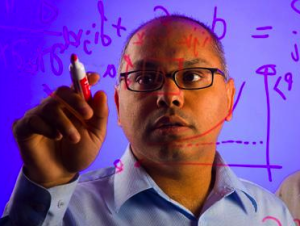A researcher with the University of Houston Cullen College of Engineering has won a $1 million grant to develop soft materials that combine mechanical strain and nanoscale effects to generate large amounts of electricity.
The three-year grant from the Qatar National Research Fund goes to Pradeep Sharma, M.D Anderson Chair Professor and department chairman of mechanical engineering. His collaborators on the project are professors Mariam Al-Maadeed and Marcelo Carignano from Qatar University and Alper Erturk from Georgia Tech.
There are a handful of naturally occurring materials, known as piezoelectrics, that convert mechanical energy to electricity and vice versa. Stretch or compress them and they generate a charge; expose them to electricity and they move. These materials can be found in everyday devices like wireless phones, which rely on piezoelectrics for their vibrate function.
While most natural piezoelectrics are hard, using soft materials with the same ability to convert mechanical energy to electricity are a subject of intense research. Such materials, for instance, can be used in stretchable electronics and could be placed in shoes to power wearable electronics or equipment used by soldiers in the field.
The material Sharma is developing starts with thin layers of soft polymers. Between the layers, he places pockets of air measuring just a few billionths of a meter. He then exposes the polymer to an electric field, which causes the air in these voids to break down and deposit electrical charges on the wall of the polymer.
“Normally, if you have embedded charges in a material, they leak out,” said Sharma. “But these embedded charges are surprisingly stable for long durations. The charges become trapped in the polymer wall.”
These trapped charges then interact with a property of the polymers known as the flexoelectricity. Similar to piezoelectricity, the flexoelectric effect converts the mechanical energy of bending or stressing a material into electricity. While the amount of energy produced by flexoelectricty is normally much lower than piezoelectricity, combining it with the charges changes that dramatically, Sharma said.
“We believe that by embedding charges in these polymers, they will interact with the flexoelectric phenomenon and cause a multiplicative effect. Basically, much more of the mechanical energy will be converted into electricity. If it works, the mechanical to electrical conversion will be 20-times more efficient.”
Sharma and his collaborators have published papers outlining the theory behind this project. With this grant, they will actually build polymer systems that offer high energy conversion levels through this flexoelectricity/electrical charge combination.
“The idea behind this is very simple. We’re trying to develop soft materials that can work mechanical vibrations and energy into electrical energy,” said Sharma. “If we can develop a soft material that has good conversion efficiency, we can power a lot of the electronics devices that people will use in the future.”
